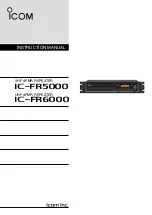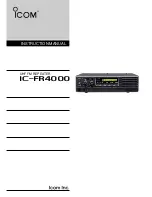
PSR78 Repeater
User Manual V0.1
Page | 13
3.2.3 Ethernet Port and Host/Remote Switch
The Ethernet Port and Host/Remote switch are located underneath the waterproof cover. Loosen the hand-
screws and remove the cover to expose the Host/Remote switch and the Ethernet port to gain access to the
system. Once the system is configured, it is recommended replace the cover and tighten the screws back into
place.
Ethernet Port
The Ethernet port can be used to communicate directly with the PSR78 using a RJ-45 crossover cable or can
also be used to connect the PSR78 to an external modem box.
Host/Remote Switch
The Host/Remote Switch allows the user to switch the default Repeater IP, Subnet Mask, and Gateway of the
repeater to an alternative setup. These settings can be adjusting by logging into the repeater in HOST mode
and configuring the settings under the Modem Box Setting section on the Install Page (section 4.4). Once
the settings are set, flipping the switch to the REMOTE position will reboot the repeater with the new alternate
settings.
Please note that when the repeater is set to the REMOTE position DHCP is disabled and the
repeater will not automatically assign an IP address to any device that connects directly to the repeater.
Figure 4: Ethernet Port and Host/Remote Switch
3.2.4 RF Ports
The donor and server antennas connect directly to the PSR78 using the ports listed below:
S7 DONOR- 700 MHz Donor Antenna
S8 DONOR- 800 MHz Donor Antenna
S7 SERVER- 700 MHz Server Antenna
S8 SERVER- 800 MHz Server Antennas
Figure 5: PSR78 RF Ports
3.2.5 Ext. ALARM Port
The PSR78 uses the open collector method. The Ext. Alarm port allows the PSR78 to send out dry contact AAI
alarms to an alarming panel. The PSR78 can receive a voltage up to +24V on the “+” line.
Figure 6: Ext. ALARM Port














































